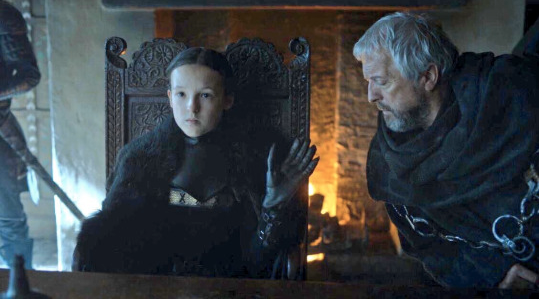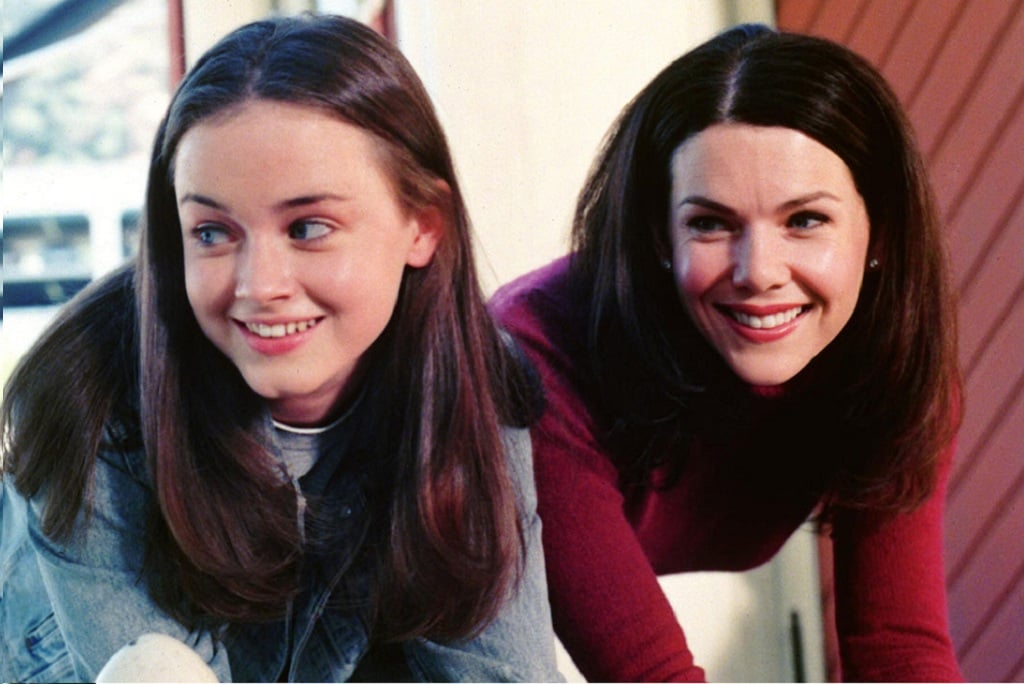Where Was The #JusticeForLane In The ‘Gilmore Girls’ Revival?
In terms of fan service, this seemed like a given.

Spoilers For Gilmore Girls: A Year In The Life and Game of Thrones.
–
For many Gilmore Girls fans, last weekend was a very emotional time — and not just because they were verklempt over seeing how good Jess Mariano still looked (really, really good, by the way). Viewers who went in expecting that creator Amy Sherman-Palladino would make up for the ‘mistakes’ made at the end of the original run of Gilmore Girls — now that she finally had the reins in her hands once more — didn’t necessarily get what they bargained for.
Some unpopular narratives and oversights from the series were addressed: it was finally acknowledged that Michel is gay and April Nardini was restricted to a small (but pretty funny) cameo. Existing problems in the show which should have stayed in 2007 — particularly some horrible fat shaming jokes, bizarre transphobic jabs, and the lack of people of colour in the cast — were sadly still present. (I still can’t believe that they cast Rose Abdoo as both Gypsy and Emily Gilmore’s new maid, as if there was a quota of non-white actors they simply could not exceed).
But the biggest shock was that there was no #JusticeForLane. One of the most consistent issues that fans take with Gilmore Girls is the narrative treatment of Rory Gilmore’s best friend (and arguably much cooler and more compelling character) Lane Kim.
–
The Ballad of Lane Kim
Lane grows up in a restrictive household, is forbidden to apply to any college of her choice and is kicked out of home when it’s revealed that she plays in a rock band. When Lane does get, as she says “a small window” of freedom, she falls pregnant with twins at 22 the first time she has (terrible, sandy, unsatisfying) sex with her new husband, Zack.
Lane always dreamed of hitting the big time with her band, Hep Alien, and at the end of season season she has made the decision to stay at home and look after her twins while Zack joins another band’s tour as their replacement guitarist. Most bands never succeed, of course, but Hep Alien actually had a chance at a record deal at one point… only Zack ruined their opportunity in a jealous rage over Brian and Lane’s friendship. Lane quietly slips into a conventional life that she had always resisted, and is left behind as Rory joins Senator Barack Obama’s campaign trail. There’s nothing wrong with a motherhood story — that can be punk too — but it became the only thing that defined Lane.
In short: Lane’s story sucked.
Every single Gilmore Girls fan I spoke to before the revival was released, expected that Lane’s story would be addressed in some capacity. Maybe she made it out of Stars Hollow! Maybe Dave rescued her! Maybe Hep Alien did rock again, or if they didn’t, Lane was using her musical talents to teach other punk teen girls to thrash out their frustration on the drums.
However, in A Year In The Life Lane Kim plays a sort of hologram who only serves to connect scenes together, remind us that we’re still in Stars Hollow and ask Rory “how are you?” every 120 minutes. We don’t hear about what has happened to her in the last nine years, except that her husband got a promotion and is deeply unhappy about it. Apart from the fact that her kids (who we don’t see her interact with and she doesn’t discuss) are eight years old now, Lane’s life has been cast in amber: she still plays with Hep Alien for fun in the same sharehouse, still goes to the Black-White-and-Read movie theatre with Brian and Zack, and still sits at Stars Hollow festival booths with her mother hovering over her. Nothing has changed. Nothing is different.
The one time in six hours that Rory asks how Lane is, Lane says, “don’t ask”.
Hep Alien Forever. pic.twitter.com/PQvzssniau
— Gilmore Girls (@GilmoreGirls) November 27, 2016
–
Hang On, Wasn’t The Revival Meant To ‘Fix’ These Things?
It’s been clear for several years that Sherman-Palladino considered it a betrayal that Gilmore Girls went on without her, and even found it too painful to watch (but she “heard about it from other people” that it didn’t match up with her original vision for the conclusion).
Because she was insistent that the show should have gone in another direction, many assumed that this meant Lane’s story — her real story — must have been drastically different (in the end it was Rory whose story was the most altered; but it still involved a surprise pregnancy).
However the A Year In The Life‘s lack of interest in Lane in any real capacity (we know more about Kirk’s life, for chrissakes) suggests that Amy Sherman-Palladino fundamentally misread the aspects of the series that people actually wanted closure on. The revival didn’t just refuse to provide ‘justice’ for Lane in allowing her to live out some of her dreams or at least have some sort of autonomy, but it treated her like a character who wasn’t even worthy of screen time.
But were we wrong to expect #JusticeForLane in the first place?
–
Fan Service Sucks! Fan Service Rules!
The idea of TV shows providing ‘justice’ for characters is common in fan communities, particularly when fans feel they are owed something by aiding a cult show to continue to run through their sheer dedication. The Gilmore Girls revival was willed into existence by avid, stubborn, emotional fans who not only wanted to visit Stars Hollow once more, but who wanted Amy Sherman-Palladino to finally get to finish her story in the right way.

The concept of fans affecting the story isn’t new. “Fan service” is a phenomenon which has long been talked about in manga and results in, as author of Understanding Manga and Anime, Robin E. Brenner, explains: “scenes that only exist to gratify the wishes of fans”. In anime this usually meant depicting female characters in overtly sexual situations, but in TV it can mean any reference to a satisfying romance, revenge scene or comedic pair-up that the audience has been clamouring for. It’s the moments that cause fans to say “yay!” because they feel like they’re being recognised.
You could say that most of the scenes between Jaime and Brienne in season three of Game of Thrones were overt fan service in referencing the abundance of fan fiction about them on the internet — many have argued that the whole of season six was powered by fan service, from the way that Jon Snow was revived, to Arya’s drawn out revenge scenes, Sansa’s cathartic speech to Ramsay before he’s savagely eaten by dogs and little Lyanna Mormont inventing riot grrrl. Game of Thrones referenced Cleganebowl to let you know that they knew you talked about it on Reddit (they didn’t do it, but still).

“Old man, pls.”
Driven by the large and vocal fan bases of shows like Game of Thrones, Lost (which spent a couple of seasons either confirming or dispelling internet fan theories and sometimes had characters like Hurley play a sort of fan forum surrogate) and in this case, Gilmore Girls, fan service can be a fun way to cater to the audience, but some argue that it ultimately hurts the integrity of the story.
When discussing Sherlock and Community for NPR, Kelly Lawler says that through”self-congratulatory winking” to the fan’s desires, these shows have become “‘Tumblr television’: a state of being where a series is not just beloved by a group of fans but actively aware of the knowledge, behaviour and expectations of those fans”.
“Fan service is kind of a cheap gimmick, like a drug thrown out to keep the fans quiet for now, in case something happens down the line that will really upset them,” she says. “It may feel really good, but it doesn’t last, and like a lot of other temporary boosts, it will one day lead to withdrawal.”
I’d argue that the very existence of Gilmore Girls: A Year In The Life is fan service in itself, so to expect that a popular character’s story would be driven by fan’s desires isn’t that far-fetched. A TV show shouldn’t necessarily bend to the wishes of its audience because then nothing bad would ever happen to any beloved character; it would be like we were reading really dull fan fiction. I think this is why I was accepting of Lane’s original story when it was released in 2007 — sometimes the coolest girl at your high school doesn’t do anything cool after graduating, sometimes your small town best friend does have babies real young.
Showrunners will never be able to please every segment of the internet and they shouldn’t try. But if this revival was meant to act as a bandaid, as a way to address the more nonsensical aspects of an Amy Sherman-Palladino-less season, then of course we expected Lane Kim’s unsatisfying story arc to be addressed.
The idea of ‘justice’ was woven into every fibre of the revival — why else would Sherman-Palladino want us to hear those ‘final four words’ we’ve been teased with for almost a decade, effectively building a a six-hour movie around them? But the problem was that Sherman-Palladino and the audience had different ideas about which storylines most deserved justice.
The silver lining: somewhere on the internet, someone is probably writing some fire Lane Kim fan fiction right now.

<3

